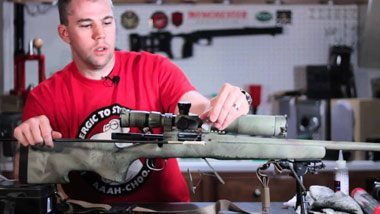 Choosing a bow is a matter of individual taste for a true bow hunter. There are four types of bow available to people to use in pursuit of their sport. The traditional longbow has been around since the dawn of time and is still a very reliable weapon. Most are made of yew and can be up to six feet long. Longbows are fired without sites and are ideal for firing at a tilt that can allow for shots at great ranges, up to 800 yards. The accuracy of a longbow is questionable, but with practice, a hunter can become proficient with one and put an arrow where he intends it to hit.
Choosing a bow is a matter of individual taste for a true bow hunter. There are four types of bow available to people to use in pursuit of their sport. The traditional longbow has been around since the dawn of time and is still a very reliable weapon. Most are made of yew and can be up to six feet long. Longbows are fired without sites and are ideal for firing at a tilt that can allow for shots at great ranges, up to 800 yards. The accuracy of a longbow is questionable, but with practice, a hunter can become proficient with one and put an arrow where he intends it to hit.
Recurve bows have a unique shape in that the tips of the bow point away from the archer when the bow is strung in a manner to make it ready for firing. Unstrung, a recurve bow looks much like a “C”. The advantage of a recurve bow is that the bow can be considerably shorter than a long bow of the same draw weight. The effective range of a recurve bow is only about 30 to 40 yards, but the accuracy is much better than the longbow. There is some release of tension when the optimum draw length is reached with an increase in the draw strength as the string reaches the firing position.
Composite bows are made of two or more materials glued or cemented together to form a stronger bow. The first composite bows were used in Egypt in about 2500 BC. The advantage of composite bows is and increased strength and heavier pull than a similar sized recurve or long bow made of a single material. Composite bows can be engineered to have specific traits based on size, draw length, and temperature to make them more accurate than simpler longbows or recurve bows.
Compound bows were introduced in the 1950s. What sets these bows apart is that the string is run through a set of cams in the ends of the limbs and actually forms an odd shaped loop. These bows are designed to have incredible draw strengths with the advantage that when the arrow reaches its draw length, the tension on the arms of the archer is reduced up to 70%. This makes it possible for the hunter to draw the arrow and hold it for a longer period while settling the bow and taking aim. This increases the accuracy of compound bows to nearly three times that of a comparable draw weight recurve bow and several times the accuracy of the longbow.
None of the newer types of bow have anywhere near the range of the longbow. However, the accuracy of these bows in their effective ranges and the strength of their draws make them lethal weapons in the hands of an experienced bow hunter who is familiar with his equipment. Choosing the right bow for your is really a matter of personal taste and how much time you are willing to put in to practicing with your equipment to assure a kill shot when you fire.
Bow Arrow Types
Archery has been a proven means of taking wild game and fighting wars since the beginning of time. Over the centuries, very little changed about the equipment until the 20th century, when advances were made by leaps and bounds. Today there are a few different arrow types from which to choose, based on what the person is planning to do with the bow and arrow.
Wooden shafts have been the mainstay of arrows since men first strung a bow. The very first were simply sharpened sticks with feathers tied to them to stabilize flight and make them more accurate. Later men learned to make sharpened flint arrowheads and tie these to the sticks for more power. As technology progressed, the material used to make the arrowheads changed through copper, bronze, and steel. The basic design of the arrows and the process of making them did not change much.
In the 20th century, men began to make arrows out of fiberglass. These had the advantage of being very lightweight, but would shatter if they hit a hard object such as a tree or a rock. Today, fiberglass arrows are used pretty much for target shooting and bow fishing only.
In the 1930s, aluminum arrow shafts were first introduced. The advantage of aluminum was found in their lightweight construction that allowed them to reach speeds in excess of 280 feet per second when fired from a recurve or compound bow. The Easton XX75 model aluminum shaft was patented in 1946 and is still a very popular arrow model today. Aluminum arrows are machined to be perfectly straight. It is, however possible for them to be bent over time or if pulled from a target incorrectly.
In the 1990s, carbon arrows were introduced. Carbon shafts are not as flawlessly straight as aluminum, but they cannot be bent without breaking. Many people see this as an advantage because bent arrows do not fly true and aluminum can be bent. Today, it is even possible to purchase composite arrows with an aluminum core encased in carbon. These are more durable than true carbon arrows, but lose a portion of their rigidity and can be bent.
In addition to the changes and advances in arrow shafts, other changes have been implemented along the way as well. In the 1950s plastic fletching was introduced to replace the arrows that have been used forever. Today’s archers can choose between feather and plastic fletching.
There are several different types of broad head arrow heads available. Some have three blades, others have four. Some are rigid, and some are expandable, meaning that the blades do not pop out until the arrow strikes a target.
Bullet or field tips are available for use as target arrows and can be purchased in the same grain weight as the broad heads used for hunting. It is, however important to fine tune one’s aim using the actual arrow heads one will hunt with if hunting is the intention of practicing archery.


Reply